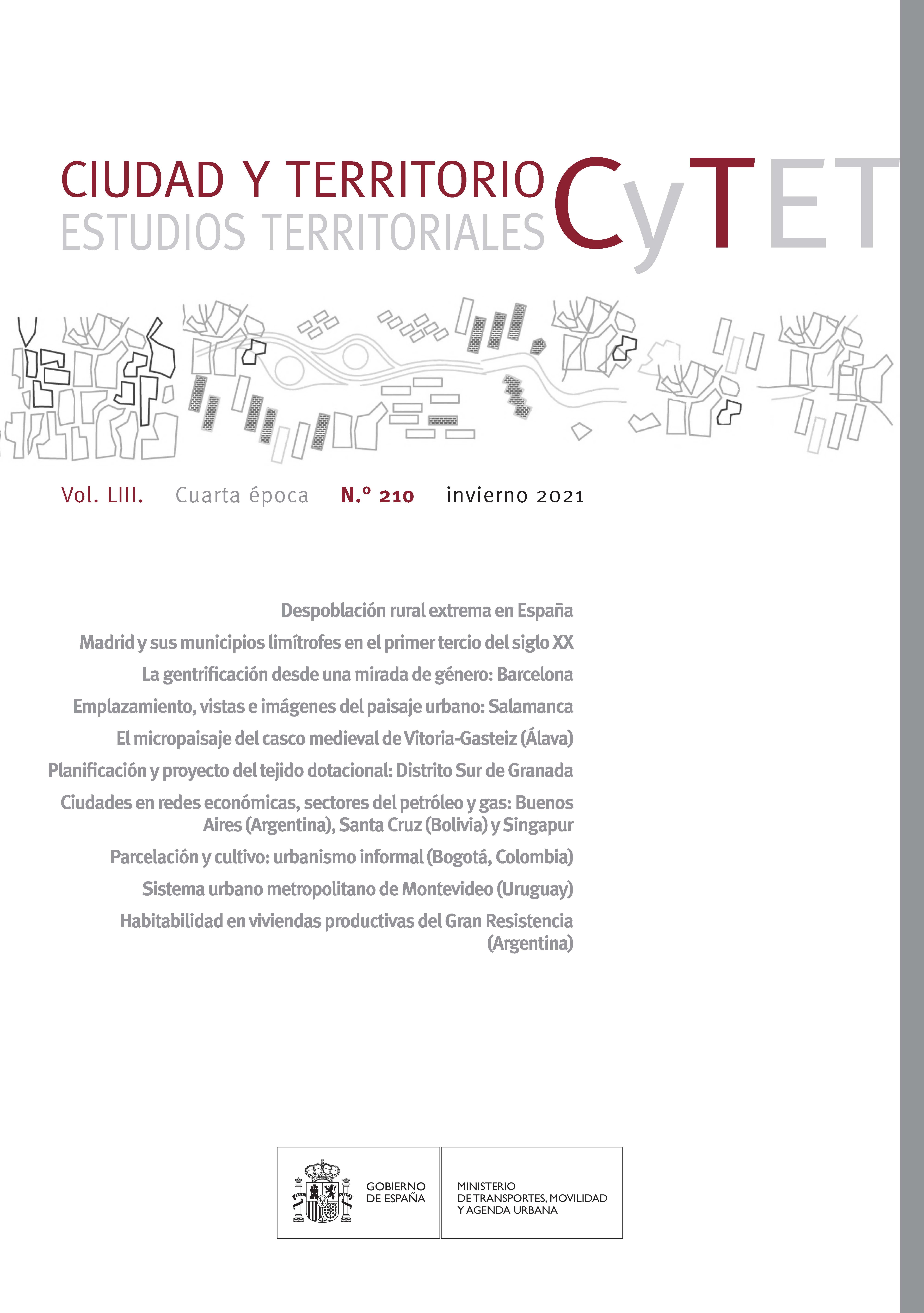La gentrificación desde una mirada de género: un ejemplo en Barcelona
DOI:
https://doi.org/10.37230/CyTET.2021.210.03Palabras clave:
Transformación social y urbana, Gentrificación, Género, BarcelonaResumen
En este artículo se analizan las repercusiones de los recientes procesos de transformación social y urbana en Barcelona con el fin de identificar experiencias y comportamientos diferenciales entre hombres y mujeres. Para ello se parte de una exploración cuantitativa, desde una perspectiva de género, de los procesos sociodemográficos de gentrificación experimentados en Barcelona entre 2011-2018. Y se complementa con una aproximación cualitativa basada en entrevistas a residentes y observaciones en asambleas de colectivos vecinales del barrio de Sant Antoni de Barcelona. Nos centramos en conocer el impacto que la gentrificación tiene sobre mujeres que viven situaciones de precariedad laboral e inseguridad residencial, y mujeres que han llegado al barrio para alquilar o comprar una vivienda atraídas por la centralidad de éste y la oferta de comercios y servicios.
Descargas
Citas
Anguelovski, I. (2014): Neighborhood as refuge: Community reconstruction, place remaking, and environmental justice in the city, Cambridge, The MIT Press.
Antón-Alonso, F. & Porcel, S. & Cruz, I. (2018): Factors contextuals associats als processos de gentrificació de l’àrea metropolitana de Barcelona. Papers: Regió Metropolitana de Barcelona: Territori, estratègies, planejament, 60: 64-79.
Atkinson, S. & Fuller, S. & Painter, J. (Eds.). (2012): Wellbeing and place . Surrey: Ashgate.
Bailey, N. & Minton, J. (2018): The suburbanisation of poverty in British cities, 2004-16: extent, processes and nature. Urban Geography, 39, nº 6: 892-915. https://doi.org/10.1080/02723638.2017.1405689
Benach, N. & Albet, A. (2018): La gentrificación como una estrategia global. Papers: Regió Metropolitana de Barcelona: Territori, estratègies, planejament, nº 60: 17-23.
Bondi, L. (1991): Gender divisions and gentrification: a critique. Transactions of the Institute of British Geographers, 16: 190-198. https://doi.org/10.2307/622613
Bondi, L. (1994): “Gentrification, work and gender identity”. En A. Kobayashi (ed.) Women, Work and Place (pp. 182-220). Quebec: McGill-Queen’s University Press.
Bondi, L. (1999): Gender, class, and gentrification: enriching the debate. Environment and Planning D: Society and Space, 17, nº 3: 261-282. https://doi.org/10.1068/d170261
Boterman, W. & Bridge, G. (2015): Gender, class and space in the field of parenthood: Comparing middle-class fractions in Amsterdam and London. Transactions of the Institute of British Geographers, 40, nº 2: 249-261. https://doi.org/10.1111/tran.12073
Buffel, T. & Phillipson, C. (2019): Ageing in a gentrifying neighbourhood: experiences of community change in later life. Sociology, pp. 1-18. https://doi.org/10.1177/0038038519836848
Buzar, S., Ogden, P. E. & Hall, R. (2005): Households matter: the quiet demography of urban transformation. Progress in Human Geography, 29, nº 4: 413-436. https://doi.org/10.1191/0309132505ph558oa
Cahill, C. (2006): At risk? The fed up honeys re-present the gentrification of the Lower East Side. Women’s Studies Quartely, 34, nº 1/2: 334-363.
Cioccoletto, A. & Col·lectiu Punt 6 (2014): Espais per a la vida quotidiana. Auditoria de qualitat urbana amb perspectiva de gènere. Barcelona: Col·lectiu Punt 6. Consulta 9 de septiembre 2020. https://issuu.com/punt6/docs/evq
Cocola-Gant, A., & López-Gay, A. (2020): Transnational gentrification, tourism and the formation of ‘foreign only’enclaves in Barcelona. Urban Studies, 57(15), 3025-3043. https://doi.org/10.1177/0042098020916111
Crespi-Vallbona, M., & Domínguez-Pérez, M. (2021): Las consecuencias de la turistificación en el centro de las grandes ciudades: el caso de Madrid y Barcelona. Ciudad Y Territorio Estudios Territoriales (CyTET), 53(M), 61-82. https://doi.org/10.37230/CyTET.2021.M21.04
Curran, W. (2018): Gender and gentrification. Oxon: Routledge.
Curran, W. & Breitbach, C. (2010): Notes on women in the global city: Chicago. Gender, Place & Culture, 17, nº 3: 393-399. https://doi.org/10.1080/09663691003737678
Donat, C. (2018): La gentrificació i el problema de l'habitatge a Barcelona. Papers: Regió Metropolitana de Barcelona: Territori, estratègies, planejament 60: 114-129.
Domínguez-Pérez, M., Leal-Maldonado, J., & Barañano-Cid, M. (2021): Vivienda, transformaciones urbanas y desigualdad socioespacial en las grandes ciudades españolas. Ciudad Y Territorio Estudios Territoriales (CyTET), 53(M), 5-12. https://doi.org/10.37230/CyTET.2021.M21.00
Ekinsmyth, C. (2002): “Feminist methodology”. En P. Shurmer-Smith (Ed.), Doing Cultural Geography (pp. 177-185). London: Sage Publications.
Fenster, T. (2004): The global city and the holy city. Narratives on knowledge, planning and diversity. Essex: Pearson.
Gilroy, R. (2012): “Wellbeing and the neighbourhood: promoting choice and independence for all ages”. En S. Atkinson, S. Fuller & J. Painter (Eds.), Wellbeing and place (pp. 73-88). Surrey: Ashgate.
Glass, R. (1964): “Introduction: aspects of change”. London: Aspects of Change. Centre for Urban Studies. London: MacKibbon and Kee.
Hochstenbach, C. & Musterd, S. (2017): Gentrification and the suburbanization of poverty: changing urban geographies through boom and bust periods. Urban Geography, 39, nº 1: 26-53. https://doi.org/10.1080/02723638.2016.1276718
Hochstenbach, C. & Boterman, W. R. (2018): “Age, life course and generations in gentrification processes”. En L. Lees y M. Phillips (Eds.), Handbook of Gentrification Studies. M. Cheltenham: Edward Elgar.
Hutton, T. A. (2009): The new economy of the inner city: restructuring, regeneration and dislocation in the 21st century metropolis. New York: Routledge.
Jack, G. (2012): “The role of place attachments in wellbeing”. En S. Atkinson & S. Fuller & J. Painter (Eds.), Wellbeing and place (pp. 89-104), Surrey: Ashgate.
Janoschka, M. & Sequera, J. & Salinas, L. (2014): Gentrification in Spain and Latin America Critical Dialogue. International Journal of Urban and Regional Research 38, nº 4: 1234-1265. https://doi.org/10.1111/1468-2427.12030
Karsten, L. (2003): Family gentrifiers: challenging the city as a place simultaneously to build a career and to raise children. Urban Studies, 40, nº 12: 2573–2584. https://doi.org/10.1080/0042098032000136228
Karsten, L. (2014): From yuppies to yupps: family gentrifiers consuming spaces and re-inventing cities. Tijdschrift voor Economische en Sociale Geografie, 105, nº 2, 175–188. doi.org/10.1111/tesg.12055
Kern, L. (2007): Reshaping the boundaries of public and private life: Gender, condominium development, and the neoliberalization of urban living. Urban Geography, 28, nº 7, 657–8. https://doi.org/10.2747/0272-3638.28.7.657
Kern, L. (2013). “All aboard? Women working the spaces of gentrification in Toronto’s Junction”. Gender, Place and Culture, 20, nº 4: 510-527. https://doi.org/10.1080/0966369X.2012.701201
Lees, L. & Slater, T. & Wyly, E. (2008): Gentrification. London: Routledge.
Lees, L. & Shin, H. B. & López-Morales, E. (2016): Planetary gentrification. John Wiley & Sons.
Lees, L. & Phillips, M. (eds.). (2018): Handbook of Gentrification Studies. Cheltenham and Northampton: Edward Elgar Publishing.
López-Gay, A. & Sales-Favà, J. & Solana-Solana, M. & Fernández, A. & Peralta, A. (2020): Midiendo los procesos de gentrificación en Barcelona y Madrid: una propuesta metodológica. En Libro de proceedings, CTV 2019: XIII Congreso Internacional Ciudad y Territorio Virtual: “Retos y paradigmas de la ciudad contemporánea”: Barcelona, octubre 2019. Barcelona: CPSV, 2019
López-Gay, A. & Sales-Favà, J. (2020): La gentrificació a la ciutat de Barcelona des d’una perspectiva de gènere: aproximació quantitativa. Departament de Transversalitat de Gènere, Ajuntament de Barcelona.
Módenes, J. A. (2019): L'insostenible augment de la inseguretat residencial a Espanya. Perspectives Demogràfiques, 13, nº 1-4. https://doi.org/10.46710/ced.pd.cat.13
Nel·lo, O. (2018): Segregació residencial, gentrificació urbana i dret a la ciutat: una lectura des de Barcelona. Papers: Regió Metropolitana de Barcelona: Territori, estratègies, planejament, 60: 48-61.
Oberhausser, A. M. & Fluri, J. L. & Whitson, R. & Mollet, S. (2018): Feminist Spaces. Gender and geography in a global context, Oxon: Routledge.
Parker, B. (2008): “Beyond the class act: gender and race in the creative class discourse”. En J. DeSena & R. Hutchinson (Eds.), Gender in an Urban World (pp. 201-232), Bingley: Emerald Group.
Sales-Favà, J. (2019): Especialització turística, gentrificació i dinàmiques residencials en un entorn urbà madur: el cas de Barcelona. Tesis doctoral. Universitat Autònoma de Barcelona, Bellaterra.
Siltanen, J. & Klodawsky, F. & Andrew, C. (2015): This is how I want to live my life”: an experiment in prefigurative feminist organizing for a more equitable and inclusive City. Antipode, 47, nº 1: 260-279.https://doi.org/10.1111/anti.12092
Smith, N. (1979): Toward a theory of gentrification a back to the city movement by capital, not people. Journal of the American Planning association, 45, nº 4: 538-548. https://doi.org/10.1080/01944367908977002
Solana-Solana, M. & López-Gay, A. & Ortiz Guitart, A. (2020): “Me están echando de mi casa”. Repercusiones personales y sociales de la inseguridad residencial en Barcelona”, Papers. Revista de Sociologia, 106, nº1: 139-162.
Vaiou, D. & Lykogianni, R. (2006): Women, neighbourhoods and everyday life. Urban Studies, 43, nº 4: 731-743. https://doi.org/10.1080/00420980600597434
Vaiou, D. (2013): “Transnational city lives: changing patterns of care and neighbouring”. En L. Peake & M. Rieker (Eds.), Rethinking feminist interventions into the urban (pp. 61-81), Oxon: Routledge.
Van der Berg, M. (2012): Femininity as a city marketing strategy: gender bending Rotterdam. Urban Studies, 49, nº 1: 153-168. https://doi.org/10.1177/0042098010396240
Van der Berg, M. (2013): City children and genderfied neighbourhoods: the new generation as urban regeneration strategy. International Journal of Urban and Regional Research, 37, nº 2: 523-536. https://doi.org/10.1111/j.1468-2427.2012.01172.x
Van der Berg, M. (2018): The discursive uses of Jane Jacobs for the genderfying city: Understanding the productions of space for post-Fordist gender notions. Urban Studies, 55, nº 4: 751-766. https://doi.org/10.1177/0042098016680519
Vollmer, L. (2019): Estrategias contra la gentrificación. Por una ciudad desde abajo. Pamplona: Katakrak Libuuak.
Walker, R. B. & Hiller, J. E. (2007): Places and health: a qualitative study to explore how older women living alone perceive the social and physical dimensions of their neighbourhoods. Social Science & Medicine, 65: 1154-1165.https://doi.org/10.1016/j.socscimed.2007.04.031
Wekerle, G. (1984): A woman's place is in the city. Antipode, 16, nº 3: 11-19. https://doi.org/10.1111/j.1467-8330.1984.tb00069.x
Wright, M. W. (2006): The gender, place & culture Jan Monk distinguished annual lecture: gentrification, assassination and forgetting in Mexico: A feminist marxist tale. Gender, Place & Culture, 21, nº 1: 1-16. https://doi.org/10.1080/0966369X.2014.882650
Publicado
Cómo citar
Número
Sección
Licencia
Derechos de autor 2021 Anna Ortiz Guitart, Antonio López Gay, Joan Sales Favá, Miguel Solana Solana

Esta obra está bajo una licencia internacional Creative Commons Atribución-NoComercial-SinDerivadas 4.0.
Sin perjuicio de lo dispuesto en la legislación vigente sobre Propiedad Intelectual, y conforme a la misma, el/la los/las autor/a/es/as que publiquen en CyTET cede/n a título gratuito, de modo no exclusivo y sin límite temporal al Ministerio de Transportes, Movilidad y Agenda Urbana los derechos para difundir, reproducir, comunicar y distribuir en cualquier formato actual o futuro, en papel o electrónico, la versión original o derivada de su obra bajo licencia de Creative Commons Reconocimiento-NoComercial-SinObraDerivada 4.0 Internacional (CC BY-NC-ND 4.0), así como para incluir o ceder a terceros la inclusión de su contenido en índices, repositorios y bases de datos nacionales e internacionales, con referencia y reconocimiento en todo caso de la autoría del mismo.
Además, al realizar el envío, el/la los/las autor/a/es/as declara/n que se trata de un trabajo original en el que se reconocen las fuentes que han sido utilizadas en su estudio, comprometiéndose a respetar la evidencia científica y a no modificar los datos originales para verificar o refutar una hipótesis de partida; que el contenido esencial del mismo no ha sido publicado previamente ni se publicará en ninguna otra obra o revista mientras esté en proceso de evaluación en la revista CyTET; y que no se ha remitido simultáneamente a otra publicación.
Los autores deben firmar un Formulario de Cesión de Derechos, que les será enviado desde la Secretaría de CyTET una vez se acepte su artículo para ser publicado.
Con el objetivo de favorecer la difusión del conocimiento, CyTET se adhiere al movimiento de revistas de Open Access (OA) y entrega la totalidad de sus contenidos a diversos índices, repositorios y bases de datos nacionales e internacionales bajo este protocolo; por tanto, la remisión de un trabajo para ser publicado en la revista presupone la aceptación explícita por parte del autor/a de este método de distribución.
Se anima a las/os autoras/es a reproducir y alojar sus trabajos publicados en CyTET en repositorios institucionales, páginas web, etc. con la intención de contribuir a la mejora de la transferencia del conocimiento y de la citación de dichos trabajos.








 Enlace a CyTET en Linkedin
Enlace a CyTET en Linkedin